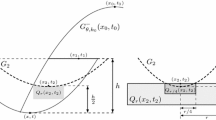Abstract
The asymptotic behavior of some semilinear parabolic PDEs is analyzed by means of a “mean value” property. This property allows us to determine, by means of appropriate a priori estimates, some exponential decay results for suitable global solutions. We also apply the method to investigate a well-known finite time blow-up result. An application is given to a one-dimensional semilinear parabolic PDE with boundary degeneracy. Our results shed further light onto the problem of determining initial data for which the corresponding solution is guaranteed to exponentially decay to zero or blow-up in finite time.



Similar content being viewed by others
References
Babin, A.V., Vishik, M.I.: Attractors of Evolution Equations. North-Holland, Amsterdam (1992)
Ball, J.M.: Continuity properties and global attractors of generalized semiflows and the Navier–Stokes equations. Nonlinear Sci. 7(5), 475–502 (1997) (corrected version appears in the book Mechanics: From Theory to Computation, Springer, New York, pp. 447–474, 2000)
Ball, J.M.: Global attractors for damped semilinear wave equations. Discrete Contin. Dyn. Syst. 10(2), 31–52 (2004)
Chepyzhov, V.V., Vishik, M.I.: Colloquium Publications. Attractors for equations of mathematical physics, vol. 49. American Mathematical Society, Providence (2002)
Fujita, H.: On the blowing up of solutions to the Cauchy problem for \(u_t = \delta u + u^{1+\alpha }\). J. Fac. Sci. Univ. Tokyo Sect. IA Math. 13, 109–124 (1966)
John, K.: Hunter and Bruno Nachtergaele, Applied Analysis. World Scientific, Hakensack (2001)
Ladyzhenskaya, O.: Attractors for Semigroups and Evolution Equations. Cambridge University Press, Cambridge (1991)
Melnik, V.S., Valero, J.: On attractors of multi-valued semi-flows and differential inclusions. Set Valued Anal. 6(1), 83–111 (1998)
Robinson, J.C.: Infinite-dimensional dynamical systems. In: Cambridge Texts in Applied Mathematics. Cambridge University Press, Cambridge (2001)
Sahoo, P.K., Riedel, T.: Mean Value Theorems and Functional Equations. World Scientific, River Edge (1998)
Segatti, A.: On the hyperbolic relaxation of the Cahn–Hilliard equation in 3-D: approximation and long time behaviour. Math. Models Methods Appl. Sci. (to appear) (2006)
Temam, R.: Applied Mathematical Sciences. Infinite-dimensional dynamical systems in mechanics and physics, vol. 68. Springer, New York (1988)
Wang, C.: Asymptotic behavior of solutions to a class of semilinear parabolic equations with boundary degeneracy. Proc. Am. Math. Soc. 141(9), 3125–3140 (2013)
Zelik, S.: Asymptotic regularity of solutions of singularly perturbed damped wave equations with supercritical nonlinearities. Discrete Contin. Dyn. Syst. 11(3), 351–392 (2004)
Zheng, S.: Monographs and Surveys in Pure and Applied Mathematics. Nonlinear evolution equations, vol. 133. Chapman & Hall/CRC, Boca Raton (2004)
Acknowledgments
The author would like to thank the referees for their generous comments when reading the manuscript.
Author information
Authors and Affiliations
Corresponding author
Appendix
Appendix
Here we report the Mean Value Theorem for Integrals that is used throughout this paper. The interested reader can also see [10, Chapter 7].
Theorem 4.1
Let \(T>0\) and \(\Omega \) be a bounded domain (open and connected) in \(\mathbb {R}^N\). Let \(f,\varphi \in C([0,T];L^1(\Omega ))\). Suppose \(\varphi (t)\) is nonnegative a.e. on \(\Omega \). Then there is \(\xi (t)\in C([0,T];\Omega )\) in which, for all \(t\in [0,T]\),
that is,
Proof
Denote by \(C_c(\Omega )\) the continuous functions on \(\Omega \) that are compactly supported in \(\Omega \) (recall that such functions are dense in \(L^p(\Omega )\), \(1\le p<\infty \)). Fix \(t'\in [0,T]\) and let \(\tilde{f}(t'),\tilde{\varphi }(t')\in C_c(\Omega )\), where \(\tilde{\varphi }(t')\) is nonnegative on \(\Omega \). By the Extreme Value Theorem for continuous functions, there exist \(x_m\) and \(x_M\) in \(\Omega \) so that
and
Hence, there holds,
Since \(\tilde{\varphi }(t')\) is nonnegative, \(|\tilde{\varphi }(t')|_{L^1(\Omega )}=\int _\Omega \tilde{\varphi }(x,t') \mathrm{{d}} x\). In the case when \(\tilde{\varphi }(t')=0\), we obtain equality and identity. So in the case when \(\tilde{\varphi }(t')\) is nonzero, we obtain
Since \(\tilde{f}(x,t')\) is continuous and \(\tilde{f}(x,t')\in [m(t'),M(t')]\), then the Intermediate Value Theorem provides an \(\xi (t')\in \Omega \) in which
Thus,
By the density of \(C_c(\Omega )\subset L^1(\Omega )\), we also have for \(f(t'),\varphi (t')\in L^1(\Omega )\),
or
So far we have shown that, for each fixed \(t'\in [0,T]\), there exists \(\xi (t') \in \Omega \) in which (41) holds. It remains to show that the map \([0,T]\ni t\mapsto \xi (t)\in \Omega \) is continuous. Let \(t^*\in [0,T]\) and \((t_n)_{n\in \mathbb {N}_{>0}}\) be such that \(t_n\rightarrow t^*\) as \(n\rightarrow \infty \). Then with the continuity of f and \(\varphi \) on [0, T],
Therefore, \(\xi \in C([0,T];\Omega )\). This finishes the proof. \(\square \)
Rights and permissions
About this article
Cite this article
Shomberg, J.L. Exponential Decay Results for Semilinear Parabolic PDE with \(C^0\) Potentials: A “Mean Value” Approach. Differ Equ Dyn Syst 26, 355–370 (2018). https://doi.org/10.1007/s12591-016-0274-1
Published:
Issue Date:
DOI: https://doi.org/10.1007/s12591-016-0274-1



